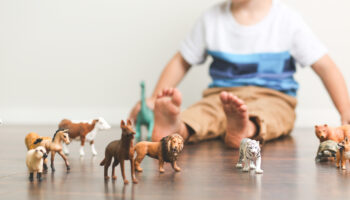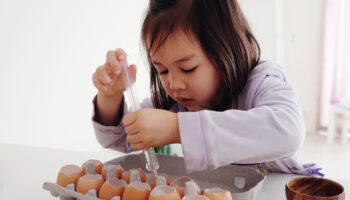Natalie Grebe
For teachers in early childhood classrooms, incorporating science into daily activities can prove quite daunting. Some educators may feel it is too costly to purchase science materials for the classroom, while others may be intimidated by their own lack of knowledge on the subject. Early childhood teachers most likely find it easier to create lessons centered on art, letter sounds and number recognition than on why the sky is blue or why plants need sunlight. With preparation and cooperative efforts, science can be a daily occurrence in the school day of the 3-5-year-old.
First, start small. Much like the classroom library, science materials can be continually added to your resources. Focus on three or four main ideas relevant to your age group. Choosing specific topics to teach will make planning and preparations less overwhelming. Topics are limitless, but a few examples are flowers, weather, environment, animals, and water. Brainstorm with coworkers about more specific details related to these topics. For instance, environment may seem like a big word to teach a 3-year old, but think of all the ways the environment is relevant to them. Living in Pennsylvania means being surrounded by grass, trees and hills. The soil contains dirt, rocks and worms. Temperatures fluctuate throughout the year. Some animals they may know, such as penguins and whales, don’t typically live in their environment, but squirrels and birds are quite common. Brainstorming will open the main topic to many specifics that are interesting to your age group.
You may be thinking, “I know my class would be interested in learning about these topics, but how do I engage them other than reading books about animals, weather or plants?” Little hands love to be busy, so creating opportunities for them to be active in their learning is critical with science. A few ways to keep the children directly involved include:
- Experience collections. Once you have decided on a topic, use a large container to begin gathering relevant items. Although some items may need to be purchased, many can be collected from families and the outside world around you. Most parents are happy to donate a bag of soil for growing flowers or a set of funnels and containers for weighing and measuring. Similarly, what jobs do the parents of your students have? A few may work in a scientific field. Ask if their company would donate any items for the classroom and promise a big thank you in next month’s newsletter for their generosity. Keep a running list of what you need to add to your box. After a few weeks, you will likely have many items ready for the children to explore and props to use during lessons.
- Direct experience. Nature walks, touching soil, feeling stones, pouring water and so many other hands on activities will keep young children engaged. “Preschool teachers can pull the science out of the environment and make it part of daily experience,” says Barbara Sprung, codirector of Educational Equity Concepts (What to Expect in Preschool, 2016). It is not enough to say, “We are going on a nature walk to look at the leaves,” and proceed in a line around the school. Allow the children to stop and touch things. Ask questions. Bring objects back to the classroom for further observation. Continue the discussion. “Talking is key…because it helps children internalize their observations and start to do the kind of higher-level thinking that enables them to begin to see the big picture” says George Tokieda, New York science teacher and curriculum developer (What to Expect, 2016).
- Take advantage of the curiosity of children. If a question of a scientific nature arises, do your best to answer it. If you don’t know the answer, that’s ok too! Tell the child, “That’s a very interesting question. I’m not sure, but let’s find out together.” When time permits, look up the answer, whether it be online, in a book or by asking someone with more knowledge of the topic. If possible, include the inquisitor in this process. Utilizing resources available to us is a critical part of science!
Cooperation among teachers within the school can also be advantageous. Planting and maintaining a vegetable garden can be overwhelming for one person. But if multiple age groups can benefit from an activity, all the teachers can participate in planning, planting, caring for and harvesting. Likewise, agree to share experience collections. Building collections with the help of 2 or 3 classroom teachers and parents will make the process more efficient. Collections can remain in 1 classroom for a designated time period, then move to another group of children.
Science in the 3-5-year old classroom is possible. Start by setting a goal to incorporate more science activities and resources into your classroom today. Devote 10 minutes a day to planning, gathering and organizing your materials. Starting small, working with others and dedication will provide multiple benefits to your classroom.
For more ideas of specific science-related activities, visit:
What to Expect in Preschool Science




